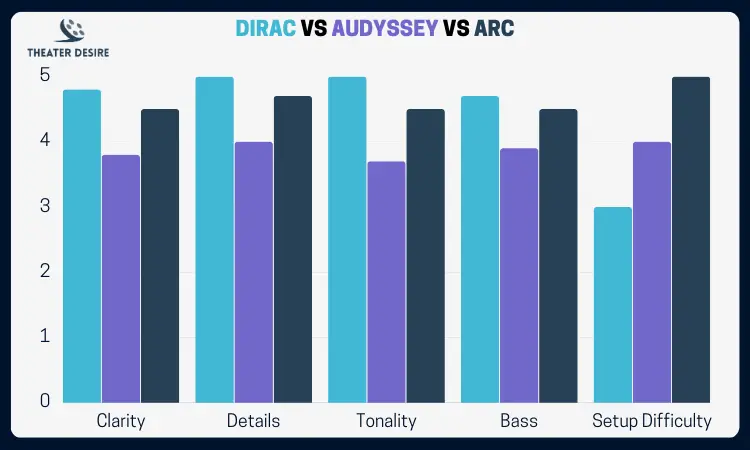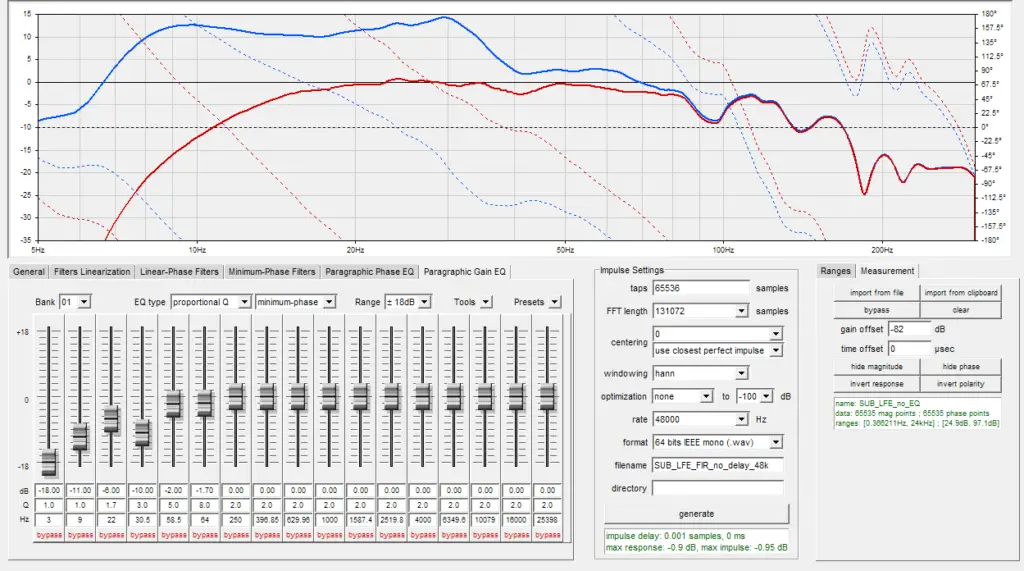More than decent speakers are needed to enjoy the best home theater experience. By that, I mean the room. The room often makes a significant difference in audio quality and immersion.
One hassle-free solution to make audio sound better in your room is to use room correction. So, Dirac vs Audyssey vs ARC, which of these room corrections is the best?
From a technological perspective, Dirac is the best audio correction technology. However, if you’re on a budget, ARC is the one to go for. I would suggest you ignore Audyssey for room correction, as it’s subpar at best.
Let’s move on to why I think Dirac is the best; I’ll start with a quick table.
Dirac vs Audyssey vs ARC: At a Glance
From a consumer standpoint, Dirac fares best, followed by ARC and Audyssey.
Unlike the differences between LFE and LFE+Main, the comparison here has more contrast. Here’s a quick table explaining the differences-
| Aspects | Dirac | Audyssey | ARC |
| Bass | Boomy | Full Range | Decent |
| Clarity | Excellent Separation | Muddy | Clear and Distinct |
| Details | Clear & Detailed | Rough | Detailed |
| Tonality | Vivid | Flat | Decent |
| Setup Difficulty | High | Medium | Low |
| Setup Costs | High | Low-High | Medium-High |
This table may need clarification, so I will make it more straightforward with a graphical representation of how I rate them out of 5 in all aspects.

Not only this, I will now attempt to explain each aspect in detail for all three.
Dirac vs Audyssey vs ARC: In-Depth Comparison
Moving on to the elements without any further ado, I will cover the tonality of the three.
Tonality:
Dirac has the most vivid tonality, followed closely by the ARC tonality. However, Audyssey has the worst tonality of the bunch.
In a more real-life situation, Dirac, when performing room correction, gives out the best tonality. I say that from experience. So, from what I’ve experienced, the sophisticated algorithm that goes into Dirac did work out. Furthermore, Dirac has impressive performance in full-range EQ.
The second one is the ARC room correction; ARC also does an excellent job in bringing out tonality but falls short of Dirac. However, ARC truly shines in full-range EQ where it almost reaches the Dirac level.
Finally, Audyssey surprised me, and not in a good way. I experienced a flat, almost dull tonality. I was expecting better room correction from what I heard about their MultEQ algorithm.
So, the winner in Tonality is Dirac, followed by ARC. The only loser here is Audyssey.
Details & Clarity:
Dirac snagged another victory in the details as I noticed better separation, clarity, and imaging than Audyssey and ARC. In this regard, ARC comes close to Dirac, but Audyssey, once again, falls short.
I tried using all three room correction technologies in my room, which I did not correctly perform sound treatment on. While straining my ear for details, I noticed most details out of Dirac.
By more details, I meant better instrumental separation and impressive vocals. ARC also impressed me in this regard. ARC and Dirac both provide excellent corrections for details.

On the contrary, compared to Dirac or ARC, Audyssey sounded muddy, at least in my room. Some users did notice good details, but the details could have been better than ARC or Dirac.
The winner in the details category is still Dirac, with ARC following closely. Audyssey is still the laggard.
Bass:
Bass correcting a room can be tricky, but all three do it fine with some minute differences. Based on my judgment of those minute differences, Dirac has the edge over the two regarding the bass correction.
However, neither Audyssey nor ARC falls too far behind on bass. So, you cannot go wrong with any of these three for bass correction.
Setup Difficulty:
ARC is the easiest to set up, followed by the Audyssey, whereas Dirac is much more complicated despite its flexibility.
Average consumers can learn and set up ARC at comparatively low effort, whereas Dirac is for professional use due to its steep learning curve. As for Audyssey, I’d place it somewhere in the middle.
The winner in setup difficulty is ARC, followed by Audyssey; Dirac is more professional in usage.
Setup Costs:
Dirac costs around $350-$500, Audyssey Costs around $200, and ARC costs around $160. So, if you strictly look at the setup costs of the room correction systems, Dirac costs the most, and ARC costs the least. Anthem falls somewhere in the middle.
So, the winner in the setup costs in ARC, followed by Audyssey, and the most budget-heavy one is Dirac.
The Room Correction You Should Go For
In most situations, the room correction system you should go for is Dirac. However, if a budget binds you, ARC is your best choice. I would not recommend getting Audyssey from what I’ve seen until now.
I say that because, so far, Dirac offers the best tonality, bass, details & clarity correction out of the ones I tested. It doesn’t consume much extra power, so it will work just fine with eco modes like Denon eco mode. Moving away from Dirac, ARC is a strong contender at a much lower price; that’s why this is the runner-up.
However, Audyssey lost on almost every front of corrections. Flat tonality, Rough details, and muddy bass- all of them make Audyssey a bad choice, in my opinion.
With that out of the way, I’ll now answer a few frequently asked questions before concluding the article.
Frequently Asked Questions (FAQs):
Does Denon have Dirac?
Yes, select models of Denon have Dirac Live. Specifically, Masimo Consumers made it available for the Denon models.
Does Marantz have Dirac live?
Yes, most models of Marantz have Dirac Live. Specifically, Masimo Consumers made it available for the Denon models.
Does Dirac work for Atmos?
Dirac works well with Atmost. Dirac has implemented ‘spatial technology’, which works especially well with Dolby Atmos.
Final Words
Hopefully, you got all the details of Dirac vs Audyssey vs ARC by now. This comparison will make your choice easy for you before choosing the right one.
Also, you now have a decent idea of good room correction systems while coming this long way.
How about it? Which room correction did you go for? Let me know in the comments below.
